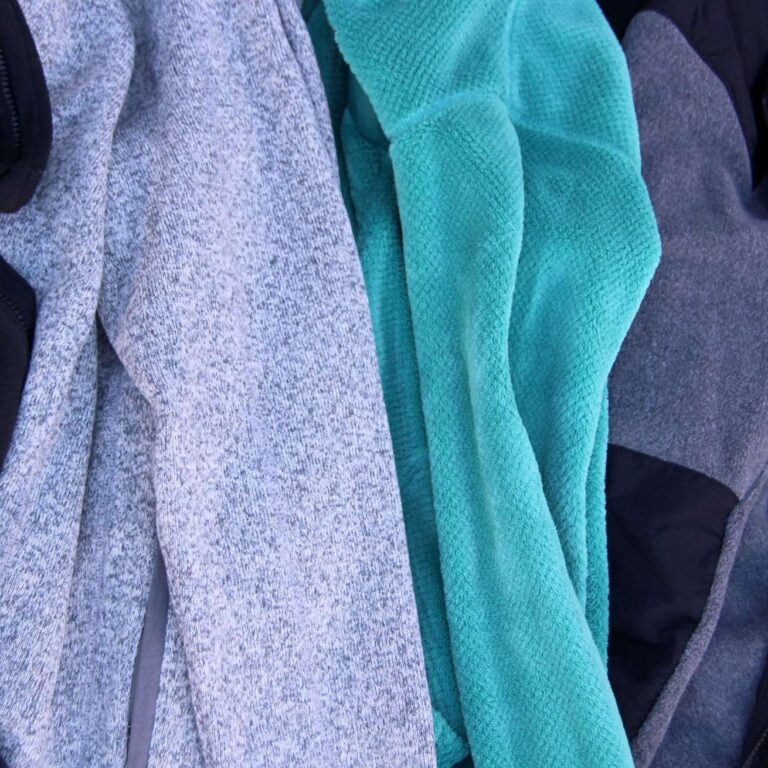There’s a reason we all love being swaddled in heaps of fabric, curled tight to fend off a cold and blustery night. Sleeping bags and backpacking quilts are a throwback to the womb. Ensconced in warmth is how we started, and it’s the main reason people love curling up in the backcountry. Well, that and survival.
If you’ve ever been backpacking or camping you know exactly what a sleeping bag is. The same is true if you’ve ever been to a sleepover party. Sleeping bags are pretty common in modern society: long, warm tubes that allow you to sleep on any surface that’s not your bed at home.

Despite the ubiquitousness of sleeping bags, there are heaps of information that elude the common user, even if that user camps and backpacks frequently. This is unfortunate because sleeping bags and backpacking quilts (I’ll get into the distinction below) are absolutely vital elements of your outdoor gear setup.
There are also so many sleeping bags and backpacking quilts on the market today that it can be hard to choose the right model for you. This guide aims to explain all the components that go into sleeping bags and backpacking quilts, from materials to features to temperature ratings. It’ll be funny on occasion, and incredibly serious on occasion (no, not really, sleeping bags are pretty silly). It will answer your questions, give you new ones, and then answer those too.
You can read the whole guide (recommended), or skip to various parts for specific information. Consult the handy Table of Contents below. Good luck, and stay warm.
Sleeping Bag and Backpacking Quilt Guide Table of Contents
- History of Sleeping Bags
- Types of Sleeping Bags
- Sleeping Bags vs Backpacking Quilts
- Sleeping Bag Insulation Type
- Sleeping Bag Temperature Rating
- Sleeping Bag Shell Fabric
- Sleeping Bag and Backpacking Quilt Features
- Sleeping Bag Care and Maintenance
- Backpacker Types
History of Sleeping Bags
While the majority of this guide is about the current sleeping bag, it’s worth talking about how this ingenious outdoor innovation came into being.
There are two accounts of the “original” sleeping bag — unless you consider the blanket, which we all know and love, to be the original sleeping bag. (Then it’s really, really old). The first account is in 1861, when Francis Fox Tuckett used a “blanket with a waterproof rubber bottom” in alpine conditions. The second is in 1876, when Pryce Pryce-Jones (yes, that’s his real name) introduced the Euklisia Rug. A rug sounds like a terrible sleeping bag, we know, but P.J.’s rug (also his real shortened name) “consisted of a wool blanket with an off-center pocket at the top for a sewn-in, inflatable, rubber pillow.” You could fold the blanket over itself, fasten it together, and sleep in roughly the same way we do in the backcountry today.

P.J.’s Euklisia Rugs were mass-produced and sold to the Russian Army in a batch of 60,000. Not too shabby, right? Things went south for said Army during the Siege of Plevna and 17,000 Rugs were never delivered. A businessman at heart, P.J. put them in his mail order catalog (yeah, he had one of those) and marketed them as an “inexpensive bedding solution for charities working with the poor.” It caught on.
Whether it’s insulation for military or the poor, sleeping bags stemmed from one central element: fending off cold. That’s probably not going to change.
Types of Sleeping Bags: Backpacking Sleeping Bags and Camping Sleeping Bags
If a sleeping bag is just a fancy blanket folded over, the outdoor industry has gone a bit wild with all the variations on that blanket. Backpacking sleeping bags and camping sleeping bags are the two categories they are usually separated into, and some bags are meant to be used for both activities. Below we'll lay out all the variations of backpacking sleeping bags and camping sleeping bags, the difference between a sleeping bag and a backpacking quilt, and the various kinds of sleeping bags and backpacking quilts now in existence.
Rectangular Sleeping Bags
This is a classic car camping sleeping bag, or a generic sleepover bag.
It has a few specific features:
- It does not taper in width, but maintains a solid rectangular shape. This provides more room for movement and sleeping in different positions.
- It rolls up rather wide and large.
- It has a zipper along one side that might go around your feet. If it goes around your feet, it can open into a full blanket.
- It may or may not have a hood, but it usually doesn’t.
- It isn’t designed for extreme warmth, so get a bag that’s rated accurately to the temperature you’ll be using it in, or a few degrees lower.
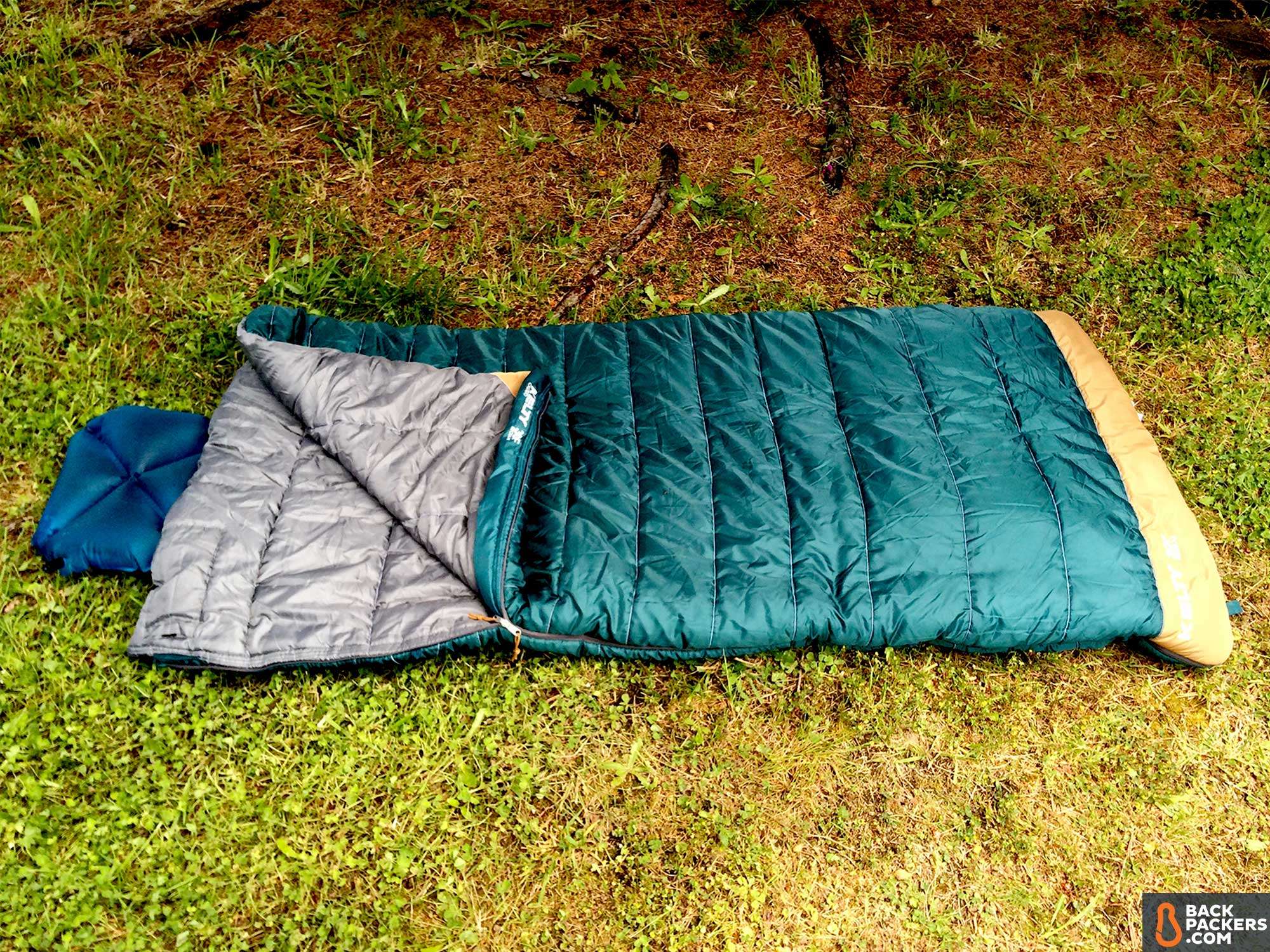
Semi-Rectangular Sleeping Bags
This shape is a slightly tapered rectangle that gets narrower towards your feet. It’s mostly a car camping sleeping bag, but it also works as a hybrid for both camping and backpacking, depending on its weight.
It has a few specific features:
- The width tapers slightly, starting wider at the shoulders and getting more narrow around the feet. This improves warmth, and still allows decent movement.
- It rolls up well.
- It has a zipper along the side.
- It probably has a hood, but not a very serious hood.
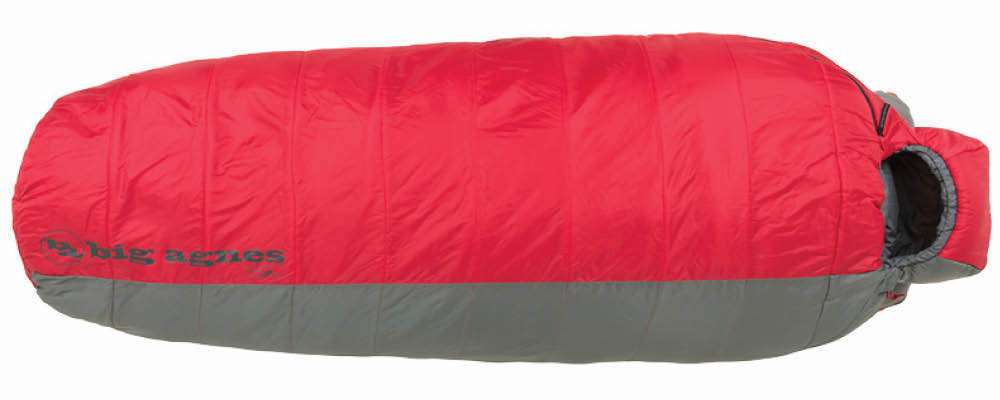
Mummy Sleeping Bags
This shape is completely tapered to your body. It’s the most popular shape for a backpacking sleeping bag, and many backpackers have (or have used) a mummy bag. It has nothing to do with Egypt — beyond lying rigidly on your back for eternal sleep.
It has a few specific features:
- Tapered design hugs the body closely. This creates a ton of warmth, but reduces movement. Sleeping on your back is best for mummy bags.
- It has a fully insulated adjustable hood. This can be tightened around your face for warmth, or let loose for a more casual fit.
- The footbox is usually reinforced and stuffed with more insulation on mummy bags so your feet stay warm and in place.
- The zipper may be on the side or down the middle. It might not go all the way down; three-fourth zippers are common on mummy bags for increasing warmth.
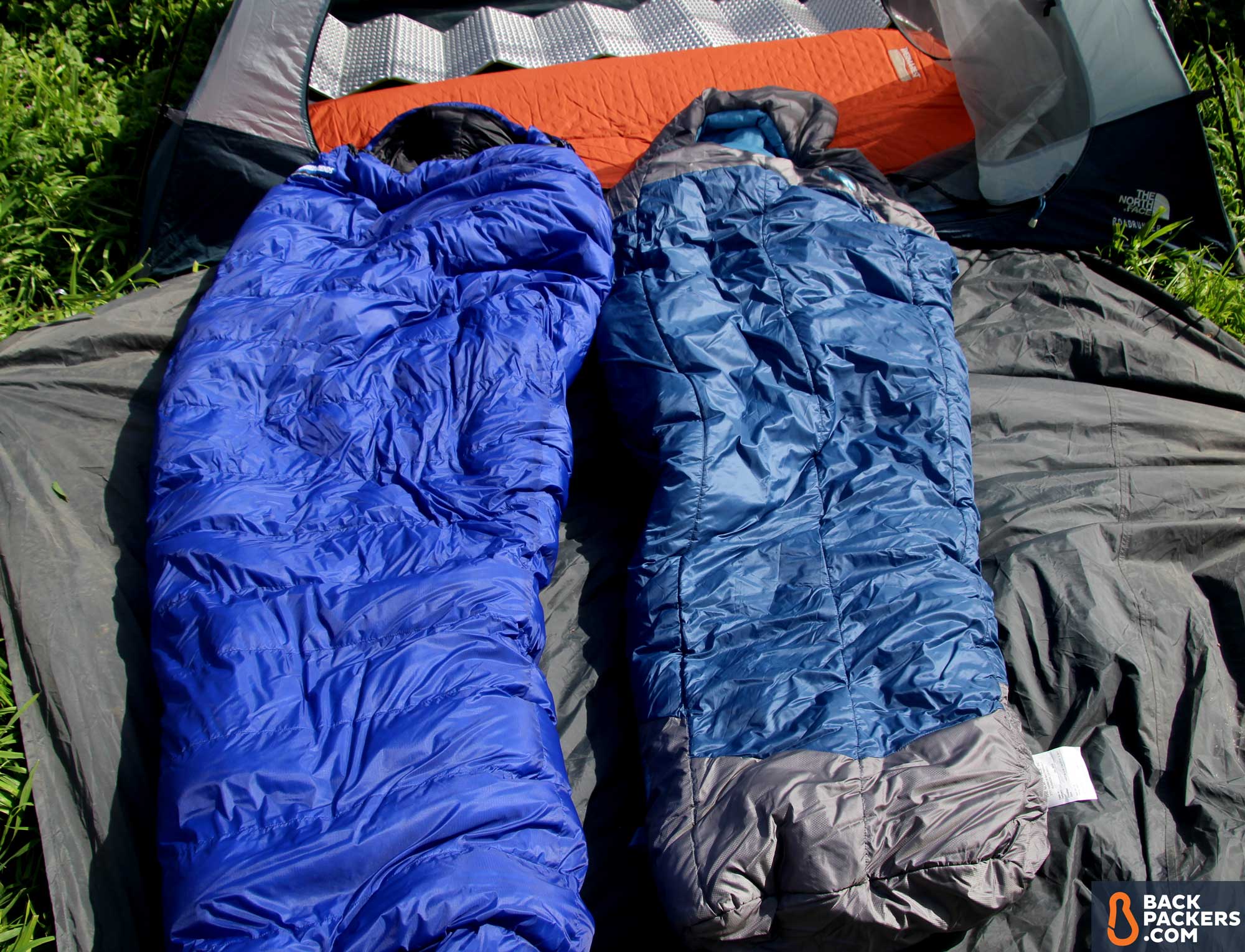
Hoodless Sleeping Bags
A newer trend, hoodless bags are not just rectangular bags with no hood. In an effort to reduce weight, manufacturers are rethinking the classic mummy bag design to create a new kind of backpacking sleeping bag.
Many feel that a hood inhibits movement, which creates a more uncomfortable sleep. If you’ve ever tried to make a pillow in a hood you know what I mean — it tends to be a hassle. Likewise, a hood is usually a redundancy because most people backpack or camp with a beanie or a jacket that has a hood. This means you might already have a way to heat your head, and the sleeping bag hood is unnecessary weight.
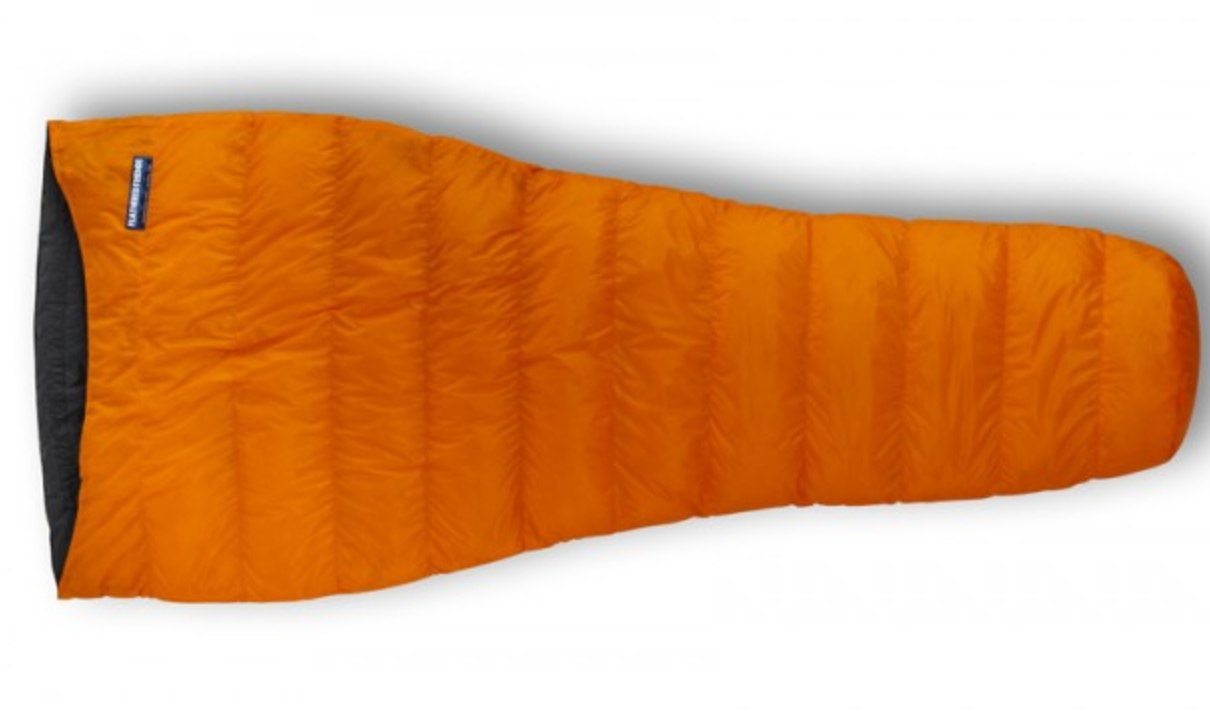
A hoodless sleeping bag takes all three of these into consideration and cuts out the hood. You are left with a tapered mummy shape that is open up top. Bring your own beanie if you get a hoodless bag.
Wearable Sleeping Bags
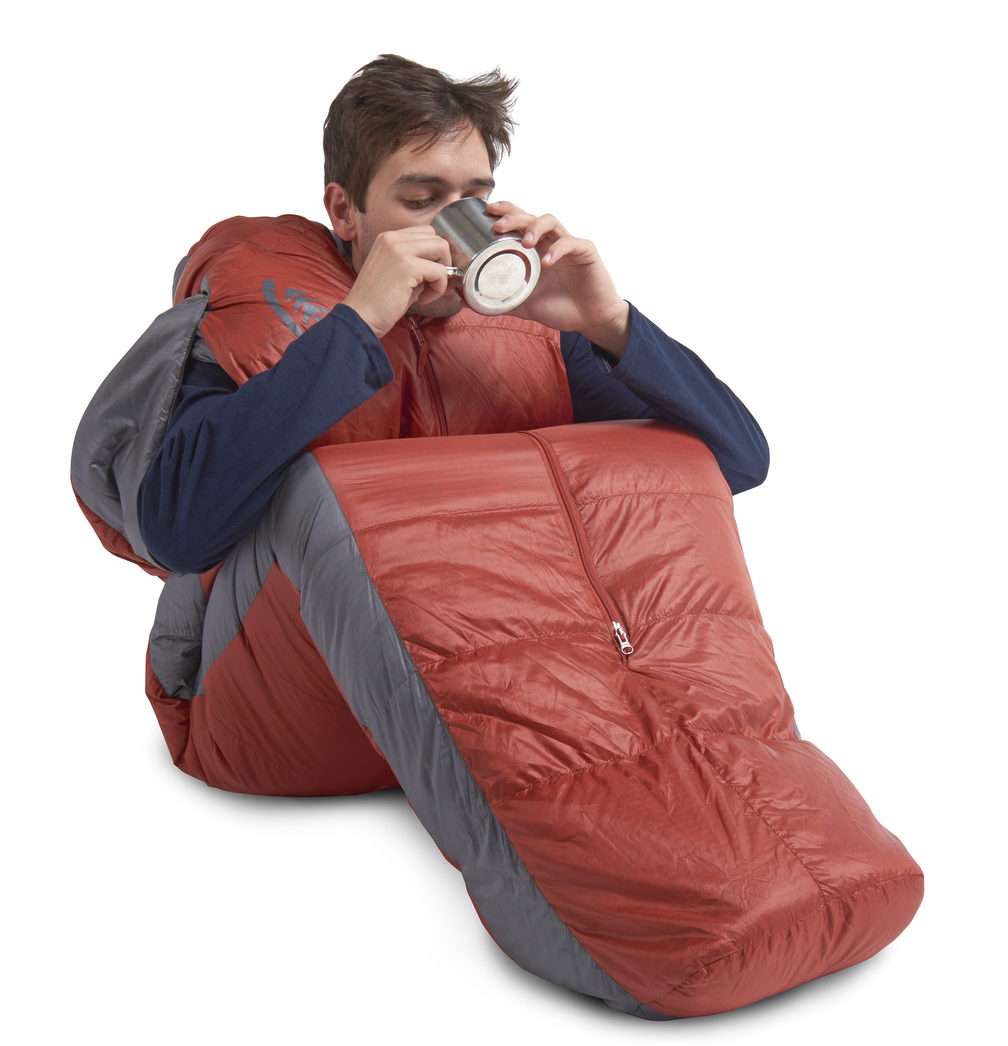
Another new trend is the wearable sleeping bag. This is also a backpacking sleeping bag, but could be used for car camping, too. Ever wish you could crawl out of your tent in the morning with your sleeping bag still tightly around you, rather than tearing back the cover and hobbling outside? This solves that terrible fate.
These bags have slits for your arms, a footbox that you can slide out of, and are completely wearable around camp. They also look really silly, and might not be very practical. How long do you really need to wear your sleeping bag for?
Some people love them though, and if the idea intrigues you it’s worth considering.
Bottomless Sleeping Bags
Another new trend is the “bottomless” sleeping bag. There actually is a bottom, but it’s a thin sheet made of different material than all these other sleeping bags. Manufacturers do this to decrease weight, and to make sure a sleeping pad fits securely (with no slippage). There are car camping sleeping bags that are “bottomless” and backpacking sleeping bags that are “bottomless.” Both list the bottoms as “sleeves”.
The philosophy behind this is the same as the philosophy behind quilts, so let’s dive right into the difference between sleeping bags and a backpacking quilt.
Sleeping Bags vs Backpacking Quilts: What is the Difference, and What is Better?
These are the questions in all of our hearts. Quilts are the hippest thing to hit backpacking since the hip belt pocket. They are lighter, smaller, way trendier, and theoretically more comfortable than sleeping bags. So, why is the outdoor industry only jumping on the backpacking quilt bandwagon now?

To answer that question we have to examine the way a sleeping bag heats you up, and how a sleeping pad helps to heat you up, too.
The Bottom of Your Sleeping Bag Is Unnecessary
To put it simply: the bottom of your sleeping bag is unnecessary.
Sleeping bags work because of the insulation stuffed inside. Whether it's down or synthetic, this insulation works by trapping the heat your body gives off. It does this through loft — the loftier the insulation, the more space there is between the filaments, which means there’s more room for that warm air to fill up, get trapped, and heat your body.
Insulation is not warm in and of itself, it actually uses your body heat and traps it. That’s why a sleeping bag warms up over time.
Think about the top of your sleeping bag when you’re lying inside. It’s warm, fluffy, and has plenty of room to expand. Now think about the bottom of your sleeping bag. You’re lying on it. And it’s lying on a pad or the ground. There is essentially no room for it to be fluffy or expand. It has almost no loft, and therefore can’t trap very much air.
This means the bottom of your sleeping bag is not adding an equal amount of warmth to your setup for the amount of weight it will always add. Arguably half the weight.

Backpacking Quilts are Sleeping Bags Without the Bottom
Backpacking quilts simply get rid of that bottom. In a rogue and somewhat comic move, quilts actually go back to the plain ol’ idea of a blanket. It’s just a sheet that covers you, like a comforter.
Unlike a comforter, a backpacking quilt is stuffed with high-end down or synthetic insulation, constructed with uber light (yet strong!) materials, and tailored to your physique. It can lie flat if you’re in a warm climate, or be strapped tightly around you in cold climates.
The real reason that backpacking quilts have not been popular until recently is because, up until the last decade or so, sleeping pads were never warm and light enough to take into the backcountry, so using a quilt was never very practical. Sleeping bag bottoms are not as thermally efficient as the tops, but they heat you up a lot more than nothing.
Backpacking Quilts Must Have a Warm Sleeping Pad To Work
If you’re camping in 75 degree weather all night, you don’t have to worry too much about the warmth your sleeping pad provides. You can probably drape your feet out of your quilt, forego a beanie, and just enjoy the night.
But for most people, the night hours are cold when camping and backpacking. Whether it’s 0 or 40 degrees Fahrenheit, you’re going to need a backpacking quilt and a pad to insulate.
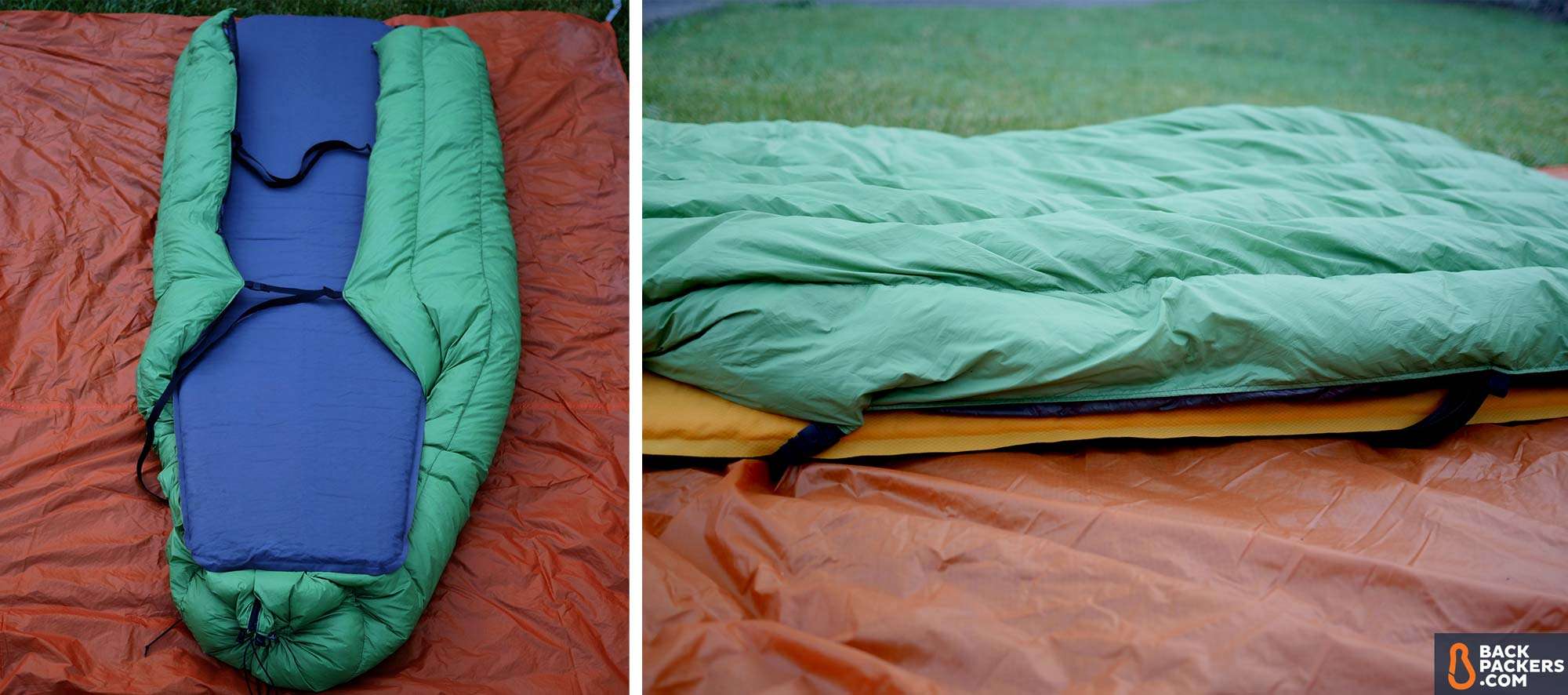
Sleeping pads have differing levels of insulation and temperature ratings, just like a quilt or sleeping bag. A backpacking quilt relies on the heat provided by a well-insulated sleeping pad to keep your back warm, then traps your warm air on the top and sides to keep you toasty all night.
If you’re considering a backpacking quilt, make sure you have a warm sleeping pad to go underneath!
Should I Get a Backpacking Quilt or Sleeping Bag?
Now that you know how and why a backpacking quilt works, the question becomes, do you want one? Sleeping bags are still by far the most common sleep method in the outdoor world, whether you’re car camping or backpacking. However, those who are looking to go ultralight are starting to favor backpacking quilts more and more.
Below is a basic pro/con list for both sleeping bags and backpacking quilts, specifically comparing each type of sleep system.
Sleeping Bag Pros
- Most traditional and easily found. There are hundreds of models from different brands, rated at different temperatures, that have years of outdoor innovation behind them. They are still the standard, and will remain that way for a while.
- They are easy to use. If you know how to zip up a zipper, you know how to use a sleeping bag. It helps if you also know how to cinch down a hood on a mummy bag, but that’s about as advanced as it gets.
- Totally ensconced. Some people like the feeling of being fully surrounded by warm fabric. A sleeping bag will always envelop you, unlike a quilt.
- Don’t always need a warm sleeping pad. In some very cold conditions a warm sleeping pad is still required, but for most campers and backpackers you don’t have to worry as much about an insulated pad to help keep you warm.
Sleeping Bag Cons
- Heavier than quilts. Weight is all relative, but a sleeping bag will always be heavier than a backpacking quilt. If weight is your main concern, a sleeping bag doesn’t make as much sense. (That said there are very light sleeping bags!)
- Takes up more space in your backpack. Weight often correlates to size, and sleeping bags will almost always be bigger than a backpacking quilt.
- Too constricting. Some people hate mummy bags. They want to sleep on their stomach or side, want to stick a leg out, or want to roll around. A sleeping bag only gives you so much space.
- Zipper snags. It’s 4AM, freezing cold, and you have to either pee or die in a bladder explosion. If your zipper snags it might just be the worst thing ever. Backpacking quilts usually don’t have zippers and are easy to get out of.
- Can’t wear around camp. With the exception of wearable sleeping bags, it’s not very practical to walk around camp in your sleeping bag. A backpacking quilt, however…
Backpacking Quilt Pros
- Weight. Duh. Backpacking quilts are crazy lightweight for their warmth.
- Tiny pack size. No zipper, bottom, or hood means backpacking quilts really do pack down tiny.
- Portable. You can wear your backpacking quilt like a cape, a blanket, or any other way around camp.
- Luxurious sleep. If you enjoy sleeping at home under a blanket more than a constricting bag, you’ll love a backpacking quilt.
- Less things to snag and break. Most backpacking quilts are free of zippers, so there’s nothing to snag, and less to break. You can always rip the fabric, but that’s true of a bag and a quilt.
- Adjustable temperature. Sometimes a sleeping bag is just too hot. A backpacking quilt you can literally push back, drape minimally, or just use on the bottom half.
Backpacking Quilt Cons
- Takes more initial time to figure out. If it’s even a little cold you’ll need to use your quilt correctly or wake up chilly. This depends on the backpacking quilt system, but usually it’s straps that secure the quilt to the pad and the sides of your body. This requires more effort than just jumping in your bag. Once you get it down, though, it’s easy.
- What if your pad fails? Backpacking quilts rely on sleeping pads for warmth, which makes them dependent. If your pad fails in the field, loses most of its loft and insulation, and you can’t fix it, it will be hard to stay warm. A sleeping bag doesn’t suffer quite as much (though you’ll still be uncomfortable).
- Not necessarily cheaper despite having less material. For the most part there are only high-end backpacking quilts (from about $200 and up), while there are many cheaper sleeping bags. Super high-end sleeping bags and backpacking quilts can cost the same amount, despite a quilt having far less material.
- No hood. Some people just can’t get over sleeping without a hood. If that’s you, a backpacking quilt might seem like a foreign entity.
- Can’t find in stores. This is changing, but most backpacking quilt manufacturers are cottage gear companies that aren’t in big-box stores or available in online retailers like Backcountry.com. It’s harder to test and see one in person.
The pro/con lists above are decently long, but not exhaustive. I’m sure we could get two bearded backpackers to argue the pros and cons of backpacking quilts over sleeping bags (or the other way around) for decades. In the end it’s a personal choice that has to do with your comfort level and sleep system.
Sleeping Bag Insulation Type: Should You Get a Synthetic or Down Sleeping Bag?
The next major consideration in the field of comfy outdoor sleep is what kind of insulation you should get. You have two choices: down or synthetic. The down vs synthetic sleeping bag debate will go on into eternity, but it’s important to know the merits of both sides.
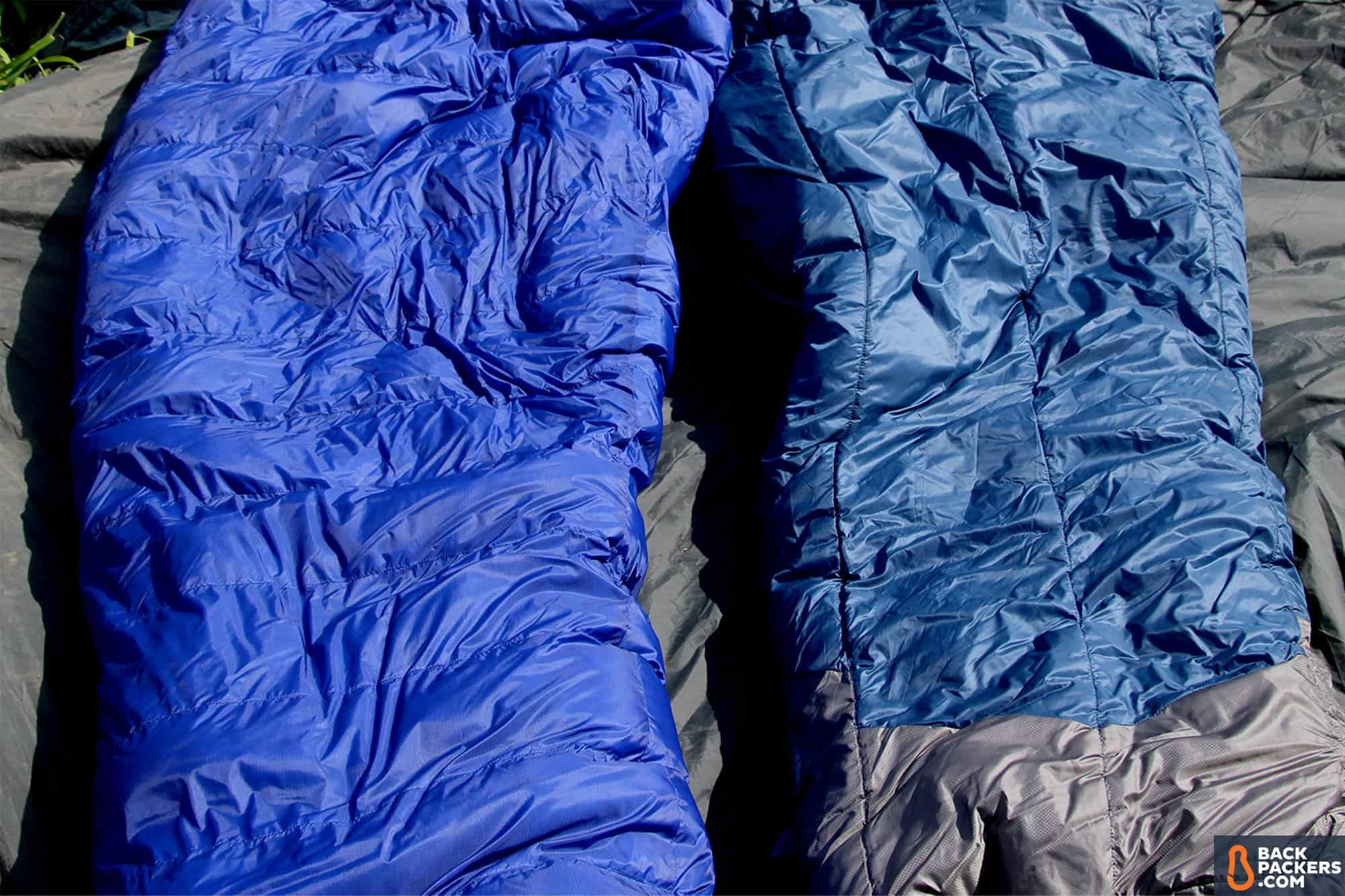
Down and synthetics are used in puffy jackets, and we have comprehensive Guides (just like this one) on both down jackets and synthetic insulated jackets. We talk about the merits of both materials in those Guides. We’ll dive into how they work in sleeping bags and backpacking quilts here.
First, it’s important to understand that synthetic insulation was created to mimic and improve upon down insulation. Therefore they both aim to warm you up through loft and trapping air, they are both stuffed and sewed into fabric, and they’re both big piles of fluffy fun.
Characteristics of Down Insulation
There are a handful of things down insulation is know for:

Best warmth to weight ratio. Down is incredibly light for the warmth it can provide. This means down sleeping bags and backpacking quilts are, on the whole, lighter than synthetics.
Lasts a long time. Down works through loft by trapping air between expanded filaments. If the loft goes away, it won’t stay as warm. Down has an amazing ability to retain loft over decades if cared for properly.
Goose or duck down. You’ll see goose or duck down available. In general it doesn’t matter much, but goose down is usually higher-end, while duck down is lower end. This is because most goose down has better loft than duck down.
Measured in fill power and fill weight. You’ll see 600-fill power duck down, 900-fill power goose down, or any number plus “fill” down in different sleeping bags and backpacking quilts. This has to do with how many cubic inches an ounce of down takes up. The higher the number, the more loft, and the more it costs. This is a complex topic that’s fully explained in our Down Jacket Guide.
Pricey and used in more high-end sleeping bags and backpacking quilts. Down is typically more expensive than synthetic when it comes to sleeping bags, especially high-end down. This is because it’s harder to find ethical sources of down, and ethical down is a rarer commodity than synthetic insulation. Due to all the reasons in this list, down sleeping bags (and jackets) are typically considered nicer, lighter, and higher quality.
Terrible when wet. It will take a lot for your down sleeping bag to totally wet out, but when it does you’re in trouble. It will stay wet, soggy, and generally unusable for many hours. This is not good on the trail, so keep it away from water.
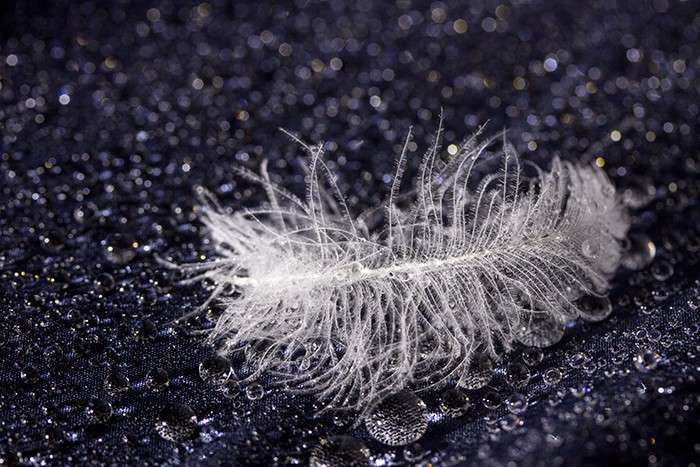
Hydrophobic down. To combat the above issue, manufacturers have started putting water-resistant coatings into down clusters to create hydrophobic down. There is a lack of clear, real-world evidence of this working significantly to keep the down from getting drenched. However, it is proven that hydrophobic down dries much faster than regular down. This is handy in sleeping bags or backpacking quilts that see a lot of soft yet consistent water.
Questionable use of animals. Most outdoor manufacturers use traceable and ethical standards for their down products today. Still, down is an animal product, and most of it is a byproduct of the meat market. A select few outdoor companies only use down that has been shed naturally, but that’s not industry standard. If you don’t want to support the meat industry as it pertains to geese and ducks, you might not want to purchase a down sleeping bag or backpacking quilt.
Down allergy. You just might be allergic to down. If this is the case, it’s a terrible choice for your sleep system. That said, most people that believe they’re allergic to down are actually allergic to the mites that live in down (yes, small unseeable creatures live in down) and potential mold spores. It’s best to make sure you’re allergic before you make the call.
Characteristics of Synthetic Insulation
Down is pretty much the bee’s knees, but synthetic insulation is very prominent in sleeping bags (and less prominent in backpacking quilts, due to their high-end-ness). Here’s why:
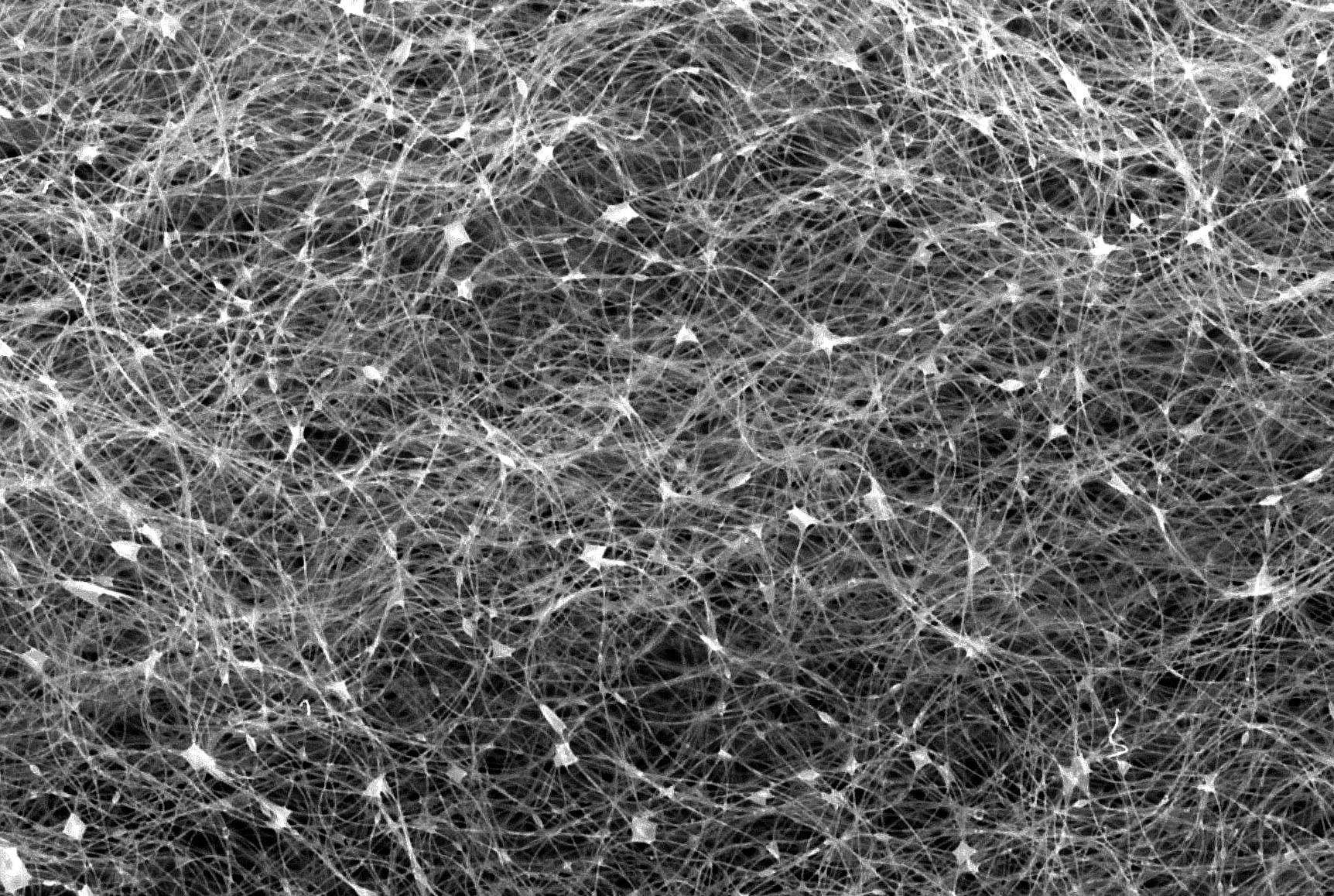
Better when wet. Synthetic insulation was literally created to combat down’s major flaw, which is that it sucks when damp and takes too long to dry. Synthetic sleeping bags and backpacking quilts aren’t completely averse to water, but they fend it off longer and dry much quicker than down. A full explanation of why is in our Synthetic Insulated Jackets Guide.
Inexpensive compared to down. You can get a pricey synthetic sleeping bag, but on the whole synthetic bags are cheaper than down bags. In part, this is because synthetic insulation is man-made and the costs are controlled. It’s also because synthetic insulation has become the standard for lower-end and heavier car camping sleeping bags or backpacking sleeping bags.
Warmth to weight ratio is not as good as down. Synthetic insulation just doesn’t compare to down if you want something very warm and very light. It can do one or the other, but both is a tall order. This means synthetic bags are generally heavier than their down counterparts. That said, synthetic insulation is improving as the years go on, so this may change over time.
Loses loft quicker than down. The truth is that synthetic insulation has never really matched up to down, and this is most noticeable over time. Synthetic sleeping bags lose their ability to loft quicker than down bags, which means they don’t hold their warmth over time. You’ll notice synthetic bags or jackets get a bit colder as the years go on.
A few primary companies produce synthetic insulation. There are a small handful of companies that produce synthetic insulation, so there’s only so much variety. You’ll see lots of interesting branded names for synthetic insulation, but know that they are all pretty similar. How the insulation is placed, and how the bag is built, is where synthetic bags really differ.
Once you’ve processed all of this information, you’ll have a decision to make: do you want a down sleeping bag, or a synthetic sleeping bag?
The three main elements to consider are cost, weight, and climate. If you enjoy following the masses, know that most wilderness backpackers spring for a lightweight down sleeping bag. Yes, it costs more, but it’s also usually lighter, lasts longer, and is warmer. If you’re looking for a car camping sleeping bag, or a hybrid that can also go on the trail, synthetic is usually the way to go.
Down or Synthetic Backpacking Quilt?
I focused primarily on sleeping bags above, but all the same principles apply to backpacking quilts. To make matters short: not many people use synthetic quilts. If they do, it’s usually because they know the benefits of synthetics and downfalls of down, and want to combat that directly.
Backpacking quilts are all about high warmth for low weight, so down is the obvious choice.
Sleeping Bag Temperature Rating
The whole point of a sleeping bag is to keep you warm. But how warm?
Sleeping bag temperature ratings are assigned to every single bag (or backpacking quilt) out there. You can usually find this in the name of the bag — like The North Face Cat’s Meow 22, or the Kelty Cosmic Down 20. The numbers in the name aren’t the exact sleeping bag temperature rating (well, sometimes they are, but as a rule don’t assume that). Instead, they are numbers to give you a general sense of what degree the bag will keep you warm.
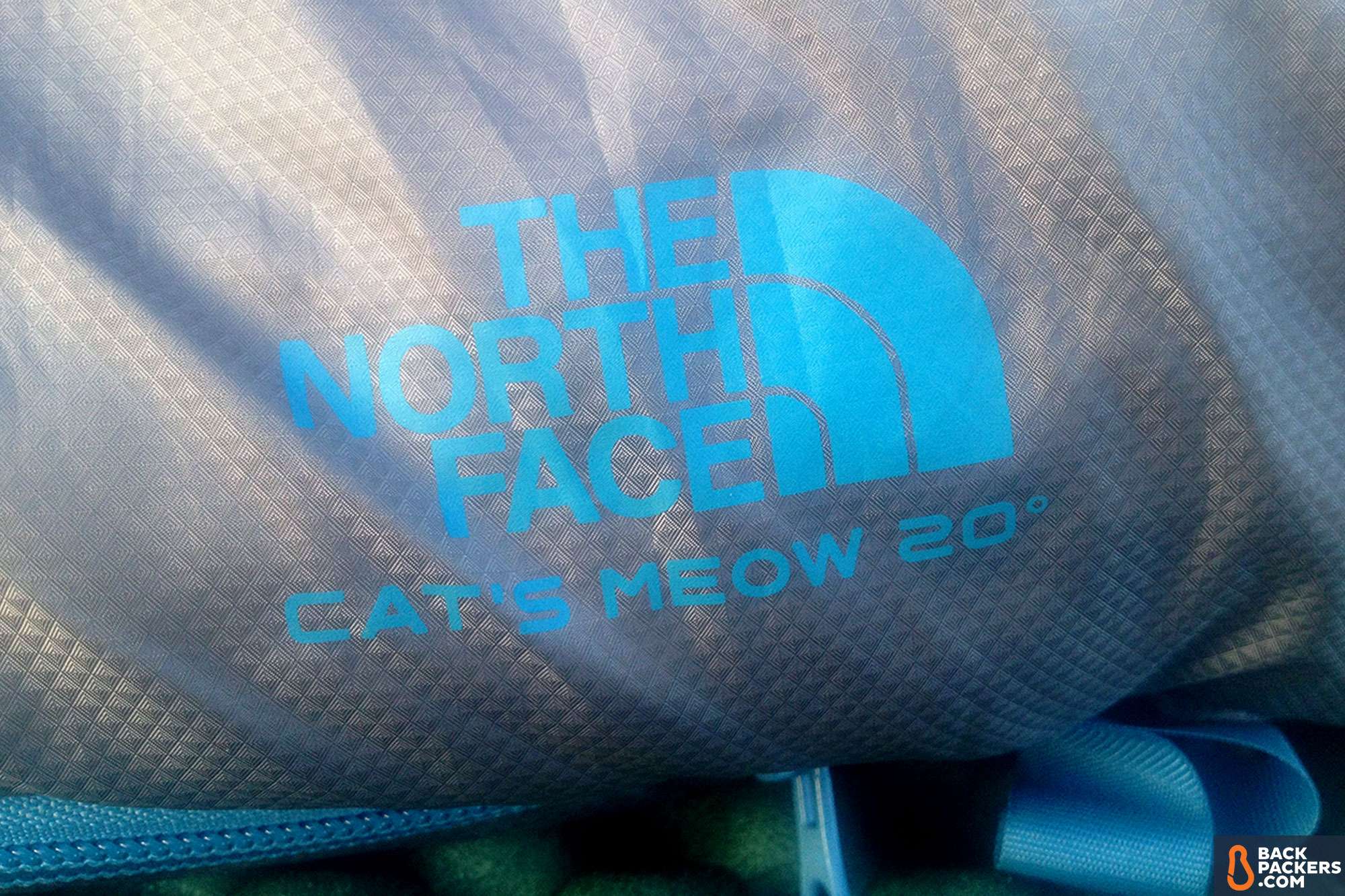
In the two examples above, 22 and 20 refer to degrees in Fahrenheit (sorry those of you not in the U.S.!) This means both bags should keep you warm roughly 10-12 degrees below freezing (32 degrees F).
While this is a good ballpark, it’s not an official measurement. And, if we're honest, most people find the stated temperature ratings to be inflated by 10 degrees.
There are two ways manufacturers give official sleeping bag temperature ratings.
The first is a generic, in-house temperature rating. This means the manufacturer has tested the bag in a variety of conditions, relatively unknown to the public, and decided that X bag is rated at Y temperature. “Rated to” in this context means that a standard user will be warm with a baselayer top and bottom, and maybe another jacket layer if it’s really cold.
Nemo Equipment is a good example of this. All their bags are rated internally, and they don’t participate in standardized testing. This works up until a manufacturer is called out by the industry for over- or under-inflating their temperature ratings. Nemo Equipment is well respected and its temperature ratings are generally accurate, but there’s no overarching way to “prove” that beyond buying the sleeping bag and trying it.
This was the only method for a long time, but the industry ran rampant with inaccurate sleeping bag temperature ratings. It made it hard to compare models for individual consumers, which is never good.
So the EN Testing was developed.
EN Testing: Official Sleeping Bag Temperature Rating
The second, and more “official” way manufacturers rate the temperature of their sleeping bags is with EN Testing. EN Testing is “is a European standard designed to standardize the sleeping bag temperature ratings manufactured and/or sold in Europe.” It is technically called the EN 13537, and was adopted by most U.S. manufacturers in the 2000’s.
It is not a legal requirement for manufacturers to get their bags EN tested, but if they do, it helps to certify that their sleeping bag temperature ratings are more standard than those who don’t.

Unlike your typical standardized test (the answer is always C, people!), the EN 13537 test involves a thermal mannequin dressed in long johns and a beanie, a climate controlled room, and the sleeping bag in question. If that sounds kinky, you’re only kind of right. If it sounds like a lack of realistic world conditions — like wind, rain, a tent, humidity etc. — you’d definitely be right.
What the EN Sleeping Bag Temperature Ratings Mean
EN testing results in four different sleeping bag temperature ratings, though only three of them are usually printed on the instruction material for a sleeping bag.
Upper Limit: This is the temperature at which a normal man, in long johns and a beanie, in a climate controlled area, will start perspiring. This is not very helpful for most consumers, and manufacturers rarely include the Upper Limit on their bags.
Comfort Limit: This is the temperature at which a normal woman will be comfortable when sleeping. The biggest issue with non-EN-tested bags is that women sleep much colder than men, usually by 10 degrees. If a woman buys a bag rated for 20 degrees F, but it’s not EN rated, be prepared for it to be comfortable at 30 degrees F (or even higher). That’s a huge difference! Know your gender and how cold you sleep, and shoot for the Comfort Limit if you’re unsure.
Lower Limit: This is the temperature at which a normal man will be comfortable sleeping. The gear industry is still heavily dominated by the male perspective, so the Lower Limit is what’s generally printed on a sleeping bag, or what the number in the name refers to. Comfortable, of course, is relative, but generally men will be nice and toasty in a bag at this number.
Extreme Limit: Just for kicks, the EN test also gives out the temperature at which a normal woman can survive for six hours without risking freezing to death. You should always be well above this number, whether you’re a man or a woman.
For reference, a “normal” man in these tests is 5’6” and 160 pounds. A “normal” woman is 5’2” and 132 pounds. Both are 25 years old, though we're not exactly sure how a mannequin represents age.
Take The EN Number with a Grain of Salt
The EN standard for sleeping bags gets a lot of flack because its conditions are so basic. But, in our estimation, it’s the first standardized test for sleeping bag temperature ratings, and that has to begin somewhere. Use these sleeping bag temperature ratings as guidelines, and encourage people to always consider their environment.
It’s best to think of this test as a guide, and to always get a bag that’s warmer than you need it to be. It’s better to be sweaty than dying of hypothermia.
Backpacking Quilt Temperature Ratings
While sleeping bags are generally EN tested by large companies, backpacking quilts are almost never tested. This is partly because most popular backpacking quilt manufacturers are cottage gear shops — they’re very small, and don’t have the need or capacity to send off samples to be tested.
The second reason (and the real reason) is because the EN tests are only for sleeping bags. The simulation doesn’t really work with a backpacking quilt. New standards could be created for quilts, but that’s a ways off.
In general backpacking quilt manufacturers use the number in the name of the product to indicate the temperature a “normal” man would be comfortable.
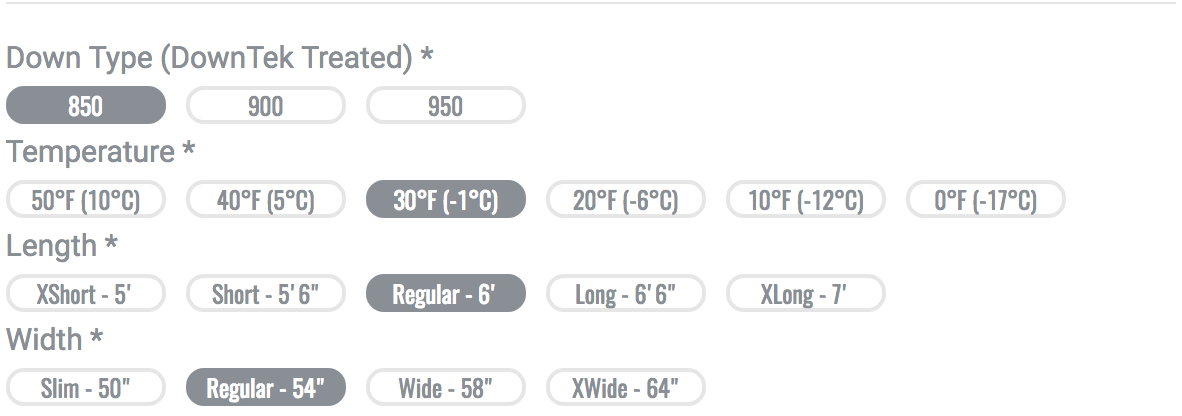
If you are a cold sleeper or a woman consult the company to see what temperature would be best. Also, keep in mind that these temperatures rely on an insulated pad and have to be correctly strapped to achieve the desired warmth.
Sleeping Bag and Backpacking Quilt Shell Fabrics
As fascinating as insulation is, there’s another major factor in the construction of a sleeping bag or backpacking quilt: shell fabrics. These are the fabrics that go around the insulation; they’re what you feel with your hands.
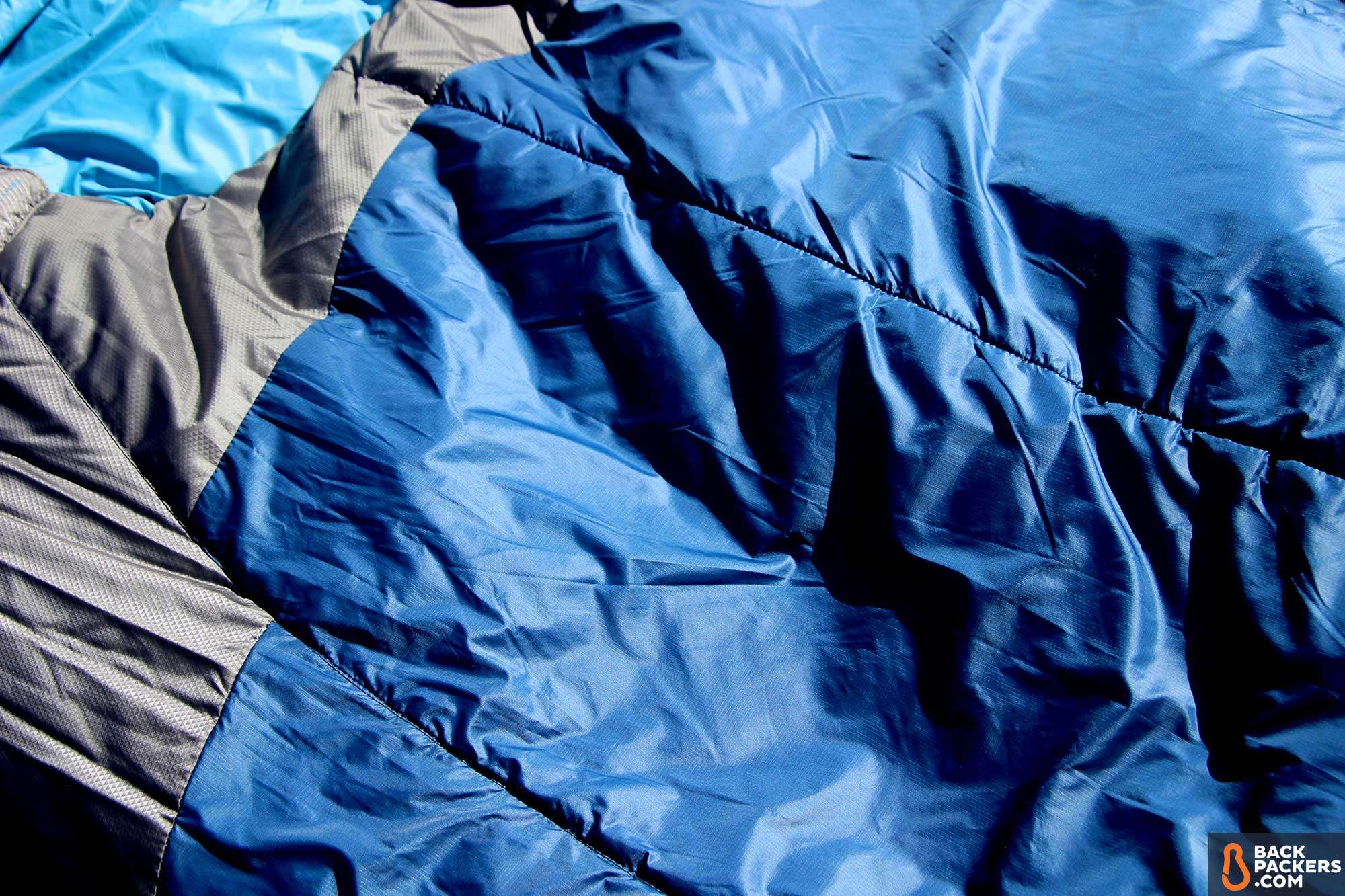
Shell fabrics are incredibly important. They factor into the overall warmth and weight of a sleeping bag or backpacking quilt. They determine a lot of the breathability and water resistance, too. Most importantly, they are the thin (hopefully strong) fabric that keeps your bag from ripping a giant hole.
There are a couple specifics to consider when looking at shell fabrics.
What is Denier Fabric? A Denier Definition
Denier, commonly abbreviated as “D”, is a unit of measurement that is used to describe the thickness of individual fibers or threads. In the backpacking world, you’ll often see 50D (or 20D, or 100D) tacked onto the end of a specification for the gear’s fabric.
This system is built on silk, weight, and the length of fabric…but it’s not a “need to know” for backpackers. So we’ll leave out the complexity of the denier definition, and focus on what it means for you.
In general Denier has to do with how thick the fibers are, which typically corresponds to that fabric’s weight and strength. This is a good Denier definition for listed numbers:
1-10-Denier: This is very, very thin thread, not often used in backpacking gear. If you see this you’ll know it’s ultralight, but not necessarily strong.
10-20-Denier: This is a standard thickness for a lot of ultralight gear, including down or synthetic jackets, backpacking quilts and some sleeping bags, and even tents. A lower Denier number doesn’t necessarily mean poor strength. There are crazy fabrics out there with lots of strength that don’t weigh much.
30-80-Denier: This thread thickness is what most outdoor gear uses. Whether it’s sleeping bags, backpacks, heavier jackets, or tents, this denier range is industry standard. It combines high strength with a reasonable weight, making sure products are durable and usable for a long time.
More Than 100-Denier: Anything over 100-Denier is a very thick thread. At this point, the higher the denier the more bomb-proof the material is going to be. You’ll see a lot of technical, hunter-esque backpacks with Denier numbers in this range. The material becomes very hard to rip, but comes with a significant weight penalty.
For sleeping bags and backpacking quilts, Denier typically ranges from 10-60 on both the exterior and interior of the bag.
Materials Used in Sleeping Bags and Backpacking Quilts: Nylon, Polyester, and Taffeta
These three materials are the usual suspects when it comes to sleeping bag and backpacking quilt fabrics. You’ll see a Denier number next to one of these, often with the word “rip-stop” next to it.
Nylon and polyester are usually on the outer part of the sleeping bag or backpacking quilt. It’s hard to generalize a difference, because every manufacturer uses a slightly different fabric. For most users, it’s not a huge deal.
Taffeta is typically used as the sleeping bag or backpacking quilt lining. It’s more comfortable, and touches your skin.
Reinforced Shell Fabric
In some sleeping bags and backpacking quilts you’ll see specific areas that are reinforced, which means there's a thicker Denier fabric there. These areas are also usually more water resistant, either with a thicker coat of DWR or something in the material to help shed water.
You’ll want to look for reinforced fabric around the feet, the head, and along the sides. These areas are what’s most prone to water or snagging, especially the feet.
Sleeping Bag and Backpacking Quilt Features
We’ve moved into the best section — the one where we define and explain nearly every feature a sleeping bag or backpacking quilt could have. This helps those new to the field to understand what they’re getting into, and gives a good general clarity to the complexity of this often-used piece of gear.
Let’s dive in.
Sleeping Bag and Backpacking Quilt Baffles
Baffles are the horizontal or vertical lines you see on backpacking quilts and sleeping bags. They are a specific kind of sewing technique to maximize the warmth and loft. You can read all about baffle construction for down jackets, but when it comes to sleeping bags and backpacking quilts, things are a bit different.
The science of baffles can get quite convoluted, but there are three types of baffles you should look for:
- Vertical Baffles: These baffles usually stretch vertically from the toebox right into the hood, or just beneath the hood, and go around the whole of the sleeping bag. Vertical baffles are not the best warmth for weight, but they usually make the fit very comfortable. You can make a hood and footbox more easily with vertical baffles.
- Horizontal Baffles: These baffles go horizontally around the bag, usually wrapping halfway or all the way around. It makes sleeping bags look like giant Michelin Man costumes, but it’s consistently better for warmth.
- Continuous Baffles: This is a specific kind of horizontal baffle. Each baffle is one single tube that wraps around the whole sleeping bag or quilt, meaning there’s no extra stitching or walls inside the baffle. This allows users to physically move the down to help regulate temperature. You can move the insulation (usually down) to the bottom or sides for less warmth, or on the top for more warmth. These are only found in high-end sleeping bags and backpacking quilts.
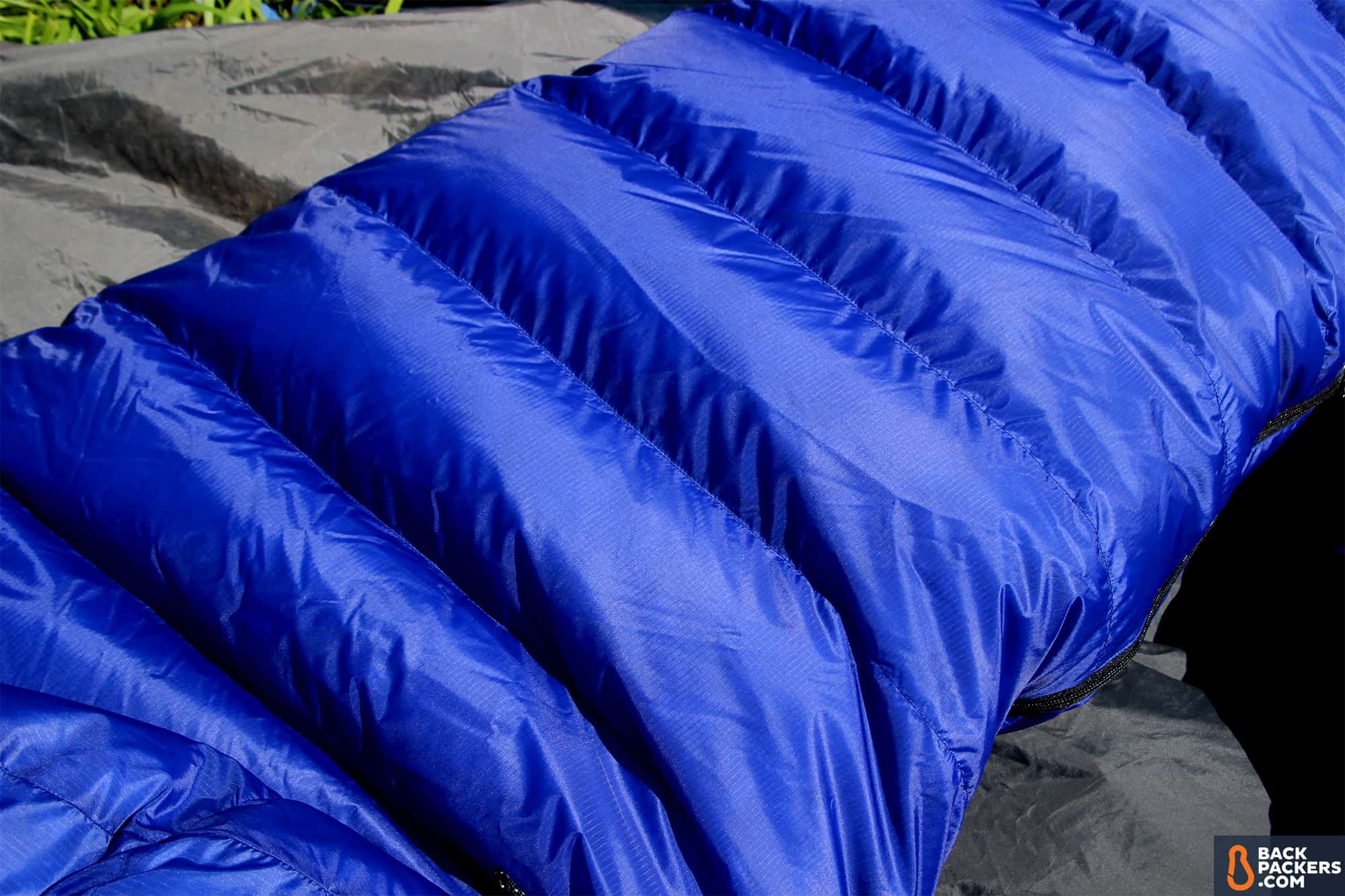
Some sleeping bags have a combination of vertical and horizontal baffles, and are trying to capitalize on the positive properties of both methods.
Sleeping Bag Hoods
Hoods are the cherry on top of the cold-fighting cake of sleeping bags. While backpacking quilts and hoodless bags are gaining traction, a hooded sleeping bag is still by far the most popular kid on the block.
There are a few things to know about hoods:
- Hood Cinch: A hood is nice, but it’s really there to help fend off extreme cold and keep in your head’s warmth. To do this effectively it needs an adjustable toggle and cinch. Some hoods have one, others have two. The cinch should be easy to operate in the dark, pull tightly around the whole of your head, and release easily.
- Down Collar: High-end down bags that are rated below freezing often have a down collar. This is a separate baffle beneath your neck that’s overstuffed with down. Added warmth and cozy as hell.
- Pillow Pocket: Some feature-filled hoods have a specific pocket for a pillow. Not a large pillow, but a place to stuff clothes, air pillows, or a compressed jacket. This is nice because it keeps your pillow from sliding around.

Sleeping Bags with Draft Tubes
A draft tube is a lot like the down collar, but it spans the entire length of your sleeping bag. It goes against the zipper, and is built to keep cold air from seeping through the zipper and into your bag.
- Extra Warm: You should definitely consider sleeping bags with draft tubes because they are a solid last line of defense for when things get uncomfortably cold.
- Can Interfere with Zippers: Draft tubes can interfere with a smooth zipping and unzipping process. Bags that are well designed will have a draft tube that doesn’t catch. Test this before you buy.
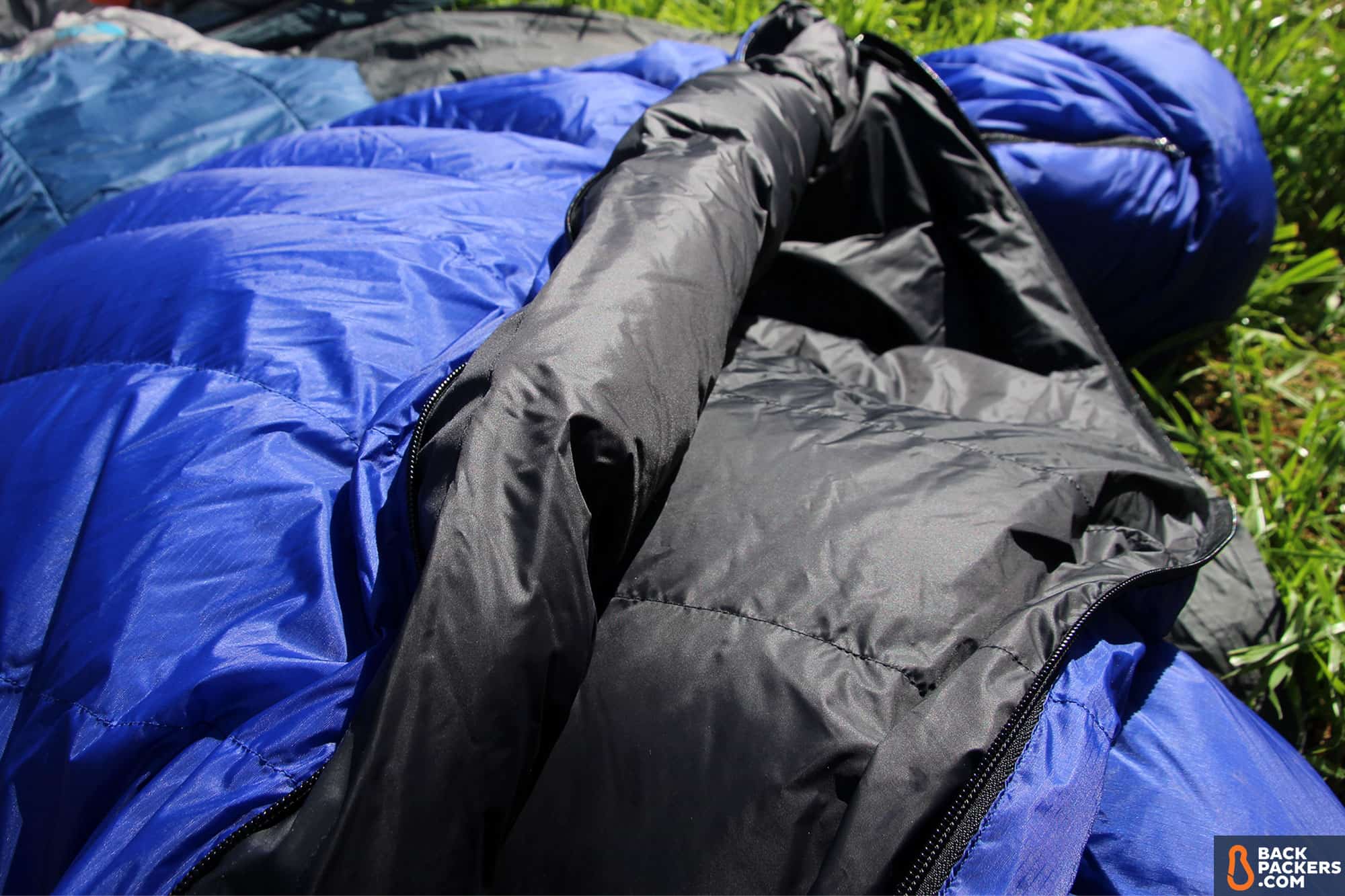
Sleeping Bag Zippers
The zippers on a sleeping bag are one of the most important elements.
- Zipper Length: You need the zipper to be the length you want (full, half, or around the feet). Make sure you know what zipper length is most comfortable for you.
- Zipper Durability: You need the zipper to last as long as the bag. Look for YKK zippers — these are industry-standard.
- Usable at Any Moment: Can you locate and unzip it at 4 a.m. in the freezing cold? You’ll need the zipper most at that critical moment, so do a few test runs with it in store.
- Heavy Duty Zipper Pulls: A small pull with no extra length for handling may cut down on weight, but doesn’t help you open the zipper.
- What Side is the Zipper On? If you want to zip two bags together for couples camping, check which side the zipper is on. There’s no standard for women or men across all the companies, so if you have a preference make sure to get the bag with the zipper on that side.

Footbox
The footbox has been mentioned before, but it’s a feature worth noting again.
- Get a Well-Fitting Footbox: You really do want a footbox that is comfortable for you. This can mean a tighter footbox for higher warmth and extreme coziness, or it can mean a wide, open footbox so you can move around. What do you prefer?
- Reinforced Footbox: The footbox tends to get the brunt of the wear, including feet stomping and moisture from the tent sides and ceiling. A reinforced footbox will not only make the bag last longer, but make sure your feet stay warm through anything.

Sleeping Bag Pockets
Some people want a no-frills bag that totally cuts down on weight. Others want a luxury bag that can hold their phone, light, and other objects close at hand. For the second group, look for sleeping bags with pockets. This is more common in car camping sleeping bags than backpacking sleeping bags, but if you search you can find pocket-filled bags for either activity. (Ultralight bags rarely have pockets.)
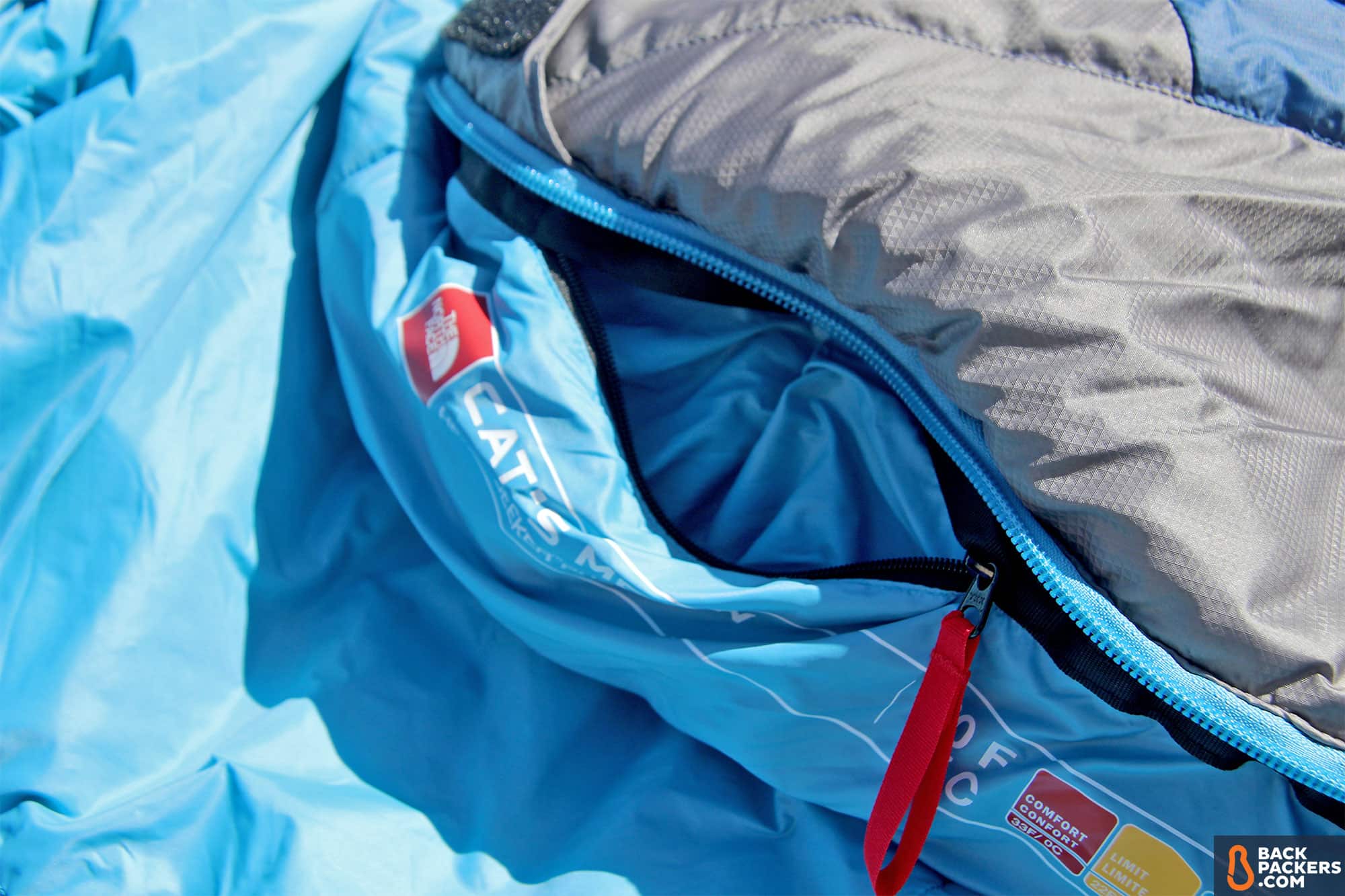
Sleeping Bag and Backpacking Quilt Cut and Length
This is a large topic entirely dependent on your body size and sleep style, so note the cut and length of the sleeping bag (or backpacking quilt) before you buy.
Men’s Bags: Men’s sleeping bags tend to be cut wide in the shoulders, narrow in the hips, and taper down towards the feet (unless it’s a rectangular bag). Men’s bags are also longer on the whole, with “Regular” fitting a six-foot-tall person.
Women’s Bags: Women’s sleeping bags tend to be cut slimmer in the shoulders, wider in the hips, and taper a little less towards the feet for more movability. Women’s bags are shorter on the whole, with a “Regular” fitting a 5’6” person.
Comfort: As we discussed in the Types of Sleeping Bags, get a bag that is cut in a way that’s comfortable for you. This includes how warm you sleep, if you sleep on your back or side or stomach, and if you like to splay your legs. There are enough options at different weights out there that anyone should be able to find the bag that fits their specific sleep situation almost perfectly.
Sleeping Bag Weight
Obviously one of the most important considerations for any backpacking sleeping bag is weight. Go with less weight and you will thank yourself in the long run. Car camping sleeping bags are not so concerned with weight, but you don’t want to get a ridiculously heavy model that takes up half the car.
Ultralight Backpacking Quilt and Sleeping Bag Weight
1-2 Pounds: This is the target weight for ultralight sleeping bags or backpacking quilts. Most backpacking quilts weigh just over one pound, while most ultralight sleeping bags hover around two pounds. This is for 3-season bags that will work in most environments.
Wilderness Backpacking Sleeping Bag Weight
2-4 Pounds: These are lightweight sleeping bags built for most backpackers. Obviously, the two-pound bags are very light and will cost more. The four-pound bags are not as light, though still manageable. A three-pound bag is the sweet spot for most backpackers, and you can get a good down bag in that weight range that won’t totally break the bank.
Car Camping Sleeping Bag Weight
5-10 Pounds: Yes, there are car camping sleeping bags that weigh ten pounds. I don’t recommend buying one, but they exist. Sleeping bags that are more than four pounds are really meant for car camping, and you shouldn’t try to take one backpacking. They’ll be too bulky to fit in your pack, and probably heavier than your tent!
Sleeping Bag Compressibility, Stuff and Storage Sacks
A sleeping bag’s compressibility is tied to its weight, but they aren't the same thing. Some sleeping bags weigh very little but don’t compress well; others weigh a moderate amount and compress excellently. This is impacted by the design, the insulation used, and the shell fabric.
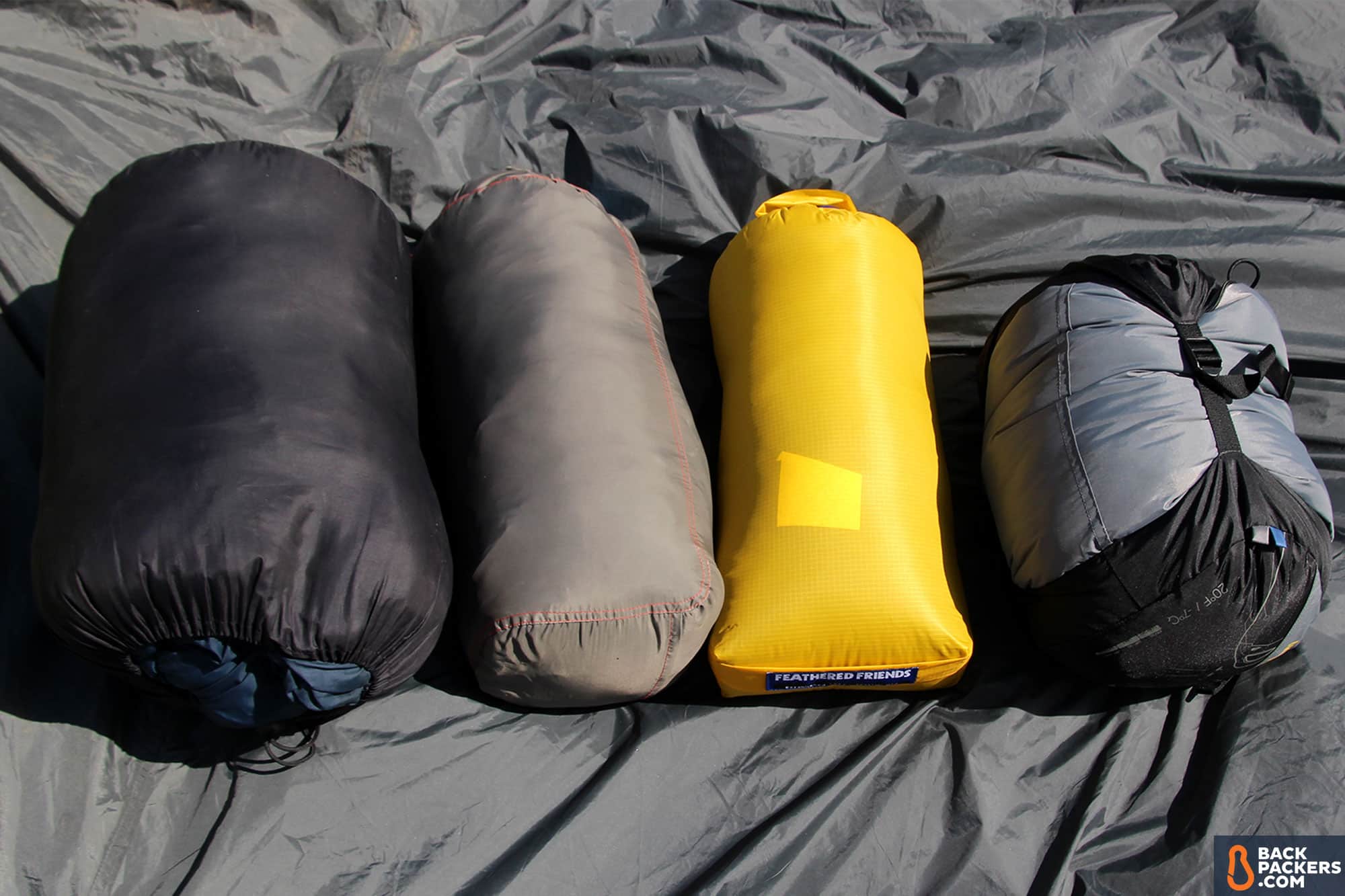
There’s also the actual stuff and storage sacks for sleeping bags and backpacking quilts, which is how most people will compress them. Here are a few tips:
- Lower weight is better than smaller size: Weight you will feel your entire hike. The size of a sleeping bag may make your pack bulge, but that’s better than it weighing a lot.
- Compressibility is nice: While weight is more important, if your bag doesn’t weigh much and stuffs down tiny you have more room for other items, or can go with a smaller (and lighter) backpack. It’s a general philosophy of “smaller is better”.
- Get a specific compression sack: A stuff sack and compression sack are two different things. The stuff sack is what comes with the bag. You should be able to fit the bag in pretty easily. A compression sack has straps to truly compress the bag, making it as small as possible.
Sleeping Bag Care and Maintenance
The last major component to sleeping bags and backpacking quilts is care and maintenance. You have to take care of the expensive thing that keeps you warm, or it will no longer keep you warm.
The good news it that sleeping bag care and maintenance is really not that complicated. It’s also the same process for backpacking quilts, so assume that all of the instructions below are for both products.
How to Store Your Sleeping Bag or Backpacking Quilt
The first component of correct sleeping bag care is to store it properly. A sleeping bag works only if the insulation has enough loft to trap warmth. Therefore, do not store the sleeping bag in a compressed state.
The best way to store a sleeping bag is in a dry, cool area (like a closet), completely open, hanging over something. This allows the insulation to stretch out, breathe, and relax instead of staying squished up tight.
If you don’t have the room for that, keep it in the included storage sack. The storage sack is not the stuff sack. The storage sack is the much larger duffle that (hopefully) came with your sleeping bag. Store your sleeping bag in this in a dry, cool environment.
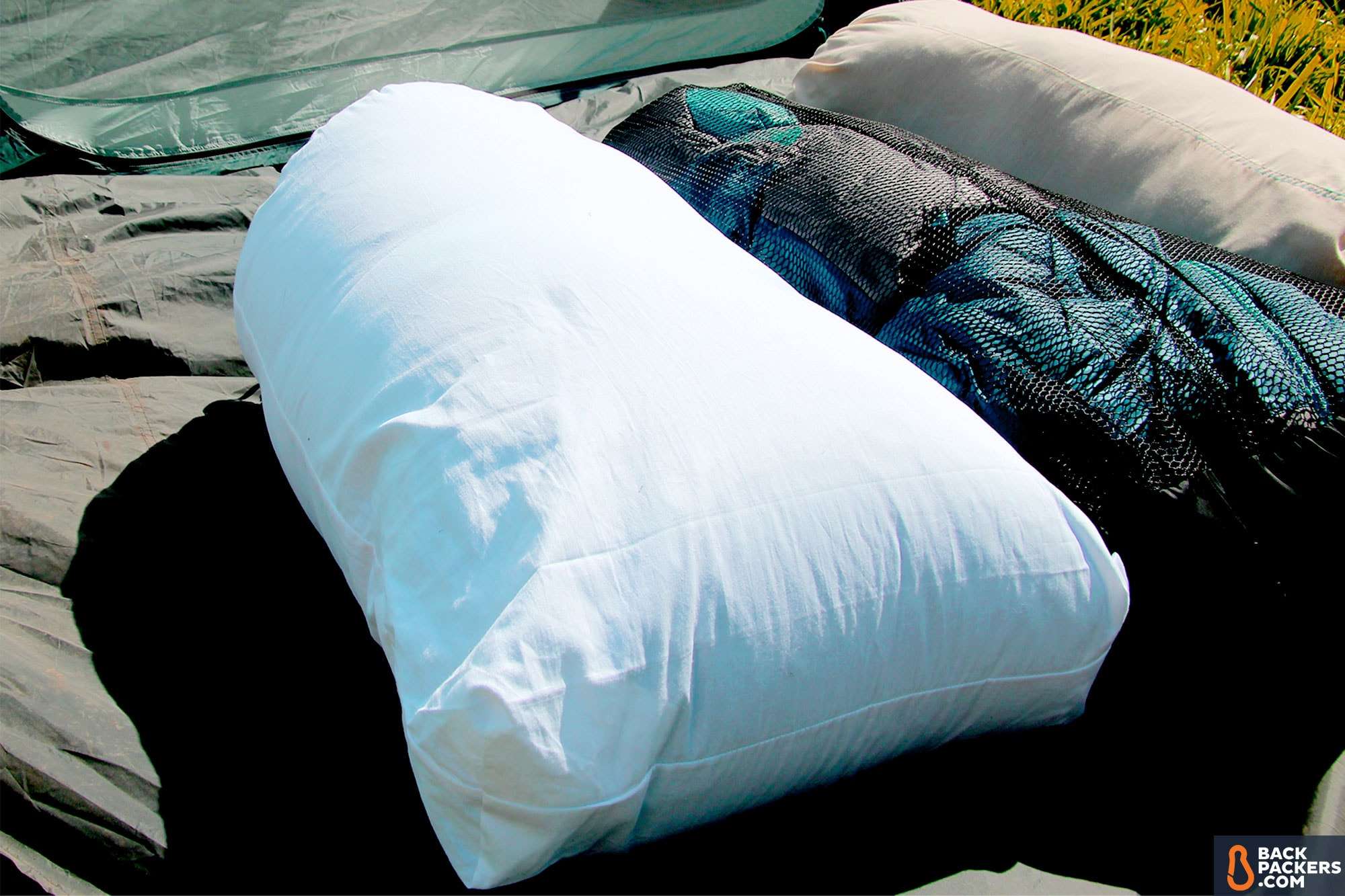
If your bag didn’t come with one, you can go buy any large container and put your sleeping bag in there, assuming it’s not compressed.
How to Wash a Down Sleeping Bag or Backpacking Quilt
Storage is all well and good, but eventually you’ll need to wash your sleeping bag. Yes, you will need to do it, because your oil, grime, dirt, and general muck is bad for the shell fabric. Also, if you have a down bag, your skin oils can seep into the feathers and shorten the lifespan considerably.
Synthetic bags can usually be thrown in the washer and dryer on a gentle cycle with ease, so they aren’t that complicated.
How to wash a down sleeping bag or backpacking quilt is a bit more complicated, but entirely doable. Here are the steps, from deciding when to wash it to letting it air dry.
1. When to Wash a Down Sleeping Bag
When your down sleeping bag or backpacking quilt has been used for a full season, smells bad, feels sweaty/sticky even if you haven’t used it in a while, or it has been a number of years, it’s time to wash it.
2. Follow Tag Instructions if Available
Most manufacturers will have a tag with instructions for washing. Find these, learn what the symbols mean, and then consult the manufacturer website. Most quality manufacturers will have specific instructions for your sleeping bag.
3. Buy Down Sleeping Bag Detergent
Your normal detergent won’t cut it for a high-end down sleeping bag. To be thorough, use the Nikwax Down Wash (or a comparable product) when washing. It’s best to buy a batch and have it on hand for any of your down products.
4. Find a Large Front-Loading Washing Machine and Dryer
If you have a large front-loading washing machine and dryer, great. You can use them. If not, consider going to a laundromat. You won’t want a top-loading washer because the agitator in the center has a strong chance of ripping the baffles in your down sleeping bag.
5. Make Sure the Washer and Dryer Are Clean and Ready to Use
Remember that sleeping bag shells are prone to rips and tears. Check the washing machine and dryer you plan to use for loose change, paper clips, or any other sharp object. Yes, do this manually with your own hands.
6. Turn the Down Sleeping Bag Inside Out
Most down sleeping bags have burlier, water-resistant shell fabric on the outside. This won’t help the water get to the down; it will inhibit it, and not clean it as well. Turn the bag inside out to make sure your down sleeping bag gets the full wash.
7. Zip All Zippers and Close All Velcro
Make sure everything is zipped up and tight. You don’t want pieces coming undone during the wash and dry cycle.
8. Wash in Cold Water on Delicate Cycle with Detergent
This is pretty simple. Make sure the water is cold and on a delicate cycle. You can wash in lukewarm water, and it will help to cleanse it more thoroughly, but cold water is always safer.
Also, make sure the place you put the down-specific detergent was clean. Use the instructions on that detergent to determine how much you need.
It may go without saying, but wash only one down sleeping bag at a time, with no other clothing or items.
9. Wash Again Without the Detergent
After your first wash the sleeping bag is relatively clean. The second wash, without the detergent, will make sure the down is free of any chemicals and ready to dry fully.
10. After Two Wash Cycles, Transport The Sleeping Bag Carefully
When a down sleeping bag is sopping wet the down has a higher chance of poking out of the shell. It is clumped, angry, and heavy in weird places.
Carry the down sleeping bag carefully from the washer to the dryer. (Yes, you can use a super-clean laundry basket instead of dramatically draping it over both arms.)
11. Dry on Low Heat for About 3 Hours
Drying the down bag is probably the least fun and most time-consuming part of this. You have to dry it on a low setting to keep the down and shell fabric intact. You also have to check the sleeping bag every 30 minutes or so and de-clump the down, because it will be sticking together.
Do this until all the clumps are separated, and the down feels relatively loose. It should also no longer be wet.
12. Let the Sleeping Bag Air Dry at Home
After the wash and dry cycle, let the down sleeping bag air out at home. Do this in a controlled environment, like a closet or garage, and don’t compress the bag at all. Let it sit there for three days.
After all of this you should be able to use a light, fluffy down sleeping bag that no longer has any smells!
Backpacker Types
A sleeping bag or backpacking quilt is an absolute essential for any backpacker. Whether you’re wilderness backpacking or car camping, you need something to cover you during sleep. Check out our thought process behind the different Backpacker Types that need a sleeping bag or backpacking quilt, and how we chose them below.
Wilderness Backpacker
The Wilderness Backpacker needs a sleeping bag, plain and simple. We recommend sleeping bags with a temperature rating between 20-30 degrees. This allows the bag to be used most of the year. While some people only want a summer or warm weather bag, we find that one sleeping bag that can “do it all” is better for most people, rather than owning multiple bags for different seasons. You can always kick out a foot or open the zipper if you’re hot.
We also recommend down mummy bags for wilderness backpackers. They are proved to be warm, light, and packable. The hood is a great feature for colder nights, and mummy bags are cut a bit wider today for more movement. Down compresses better, lasts longer, and is generally warmer than synthetic.
Ultralight Backpacker
Ultralight Backpackers need everything the Wilderness Backpacker needs, but it has to be light. As in, under two pounds. Still best for three-season use, we recommend backpacking quilts and super-light sleeping bags for the discerning Ultralight Backpacker. As weight is the primary concern, down, and high-end down, is a must for Ultralight Backpackers.
Keep in mind a backpacking quilt requires a solid sleeping pad that can keep you warm, so if you go this route know what you’re getting into.
Car Camper
Car camping sleeping bags are a whole other story. Weight is not a concern; neither is compressibility. You still want a three-season bag, but luxury features are nice. A bag that opens completely to form a blanket, a bag that has an area for a full pillow (and no hood), and bags that have pockets for phones and other essentials are what we recommend.
On the whole we think car camping sleeping bags should not cost more than $200, which is starkly different than the other Backpacker Types above. This means we like synthetic bags for car camping.
Affiliate Policy: We support the hours that go into our reviews, testing, and guides through affiliate commissions on purchases made through links in this article.


